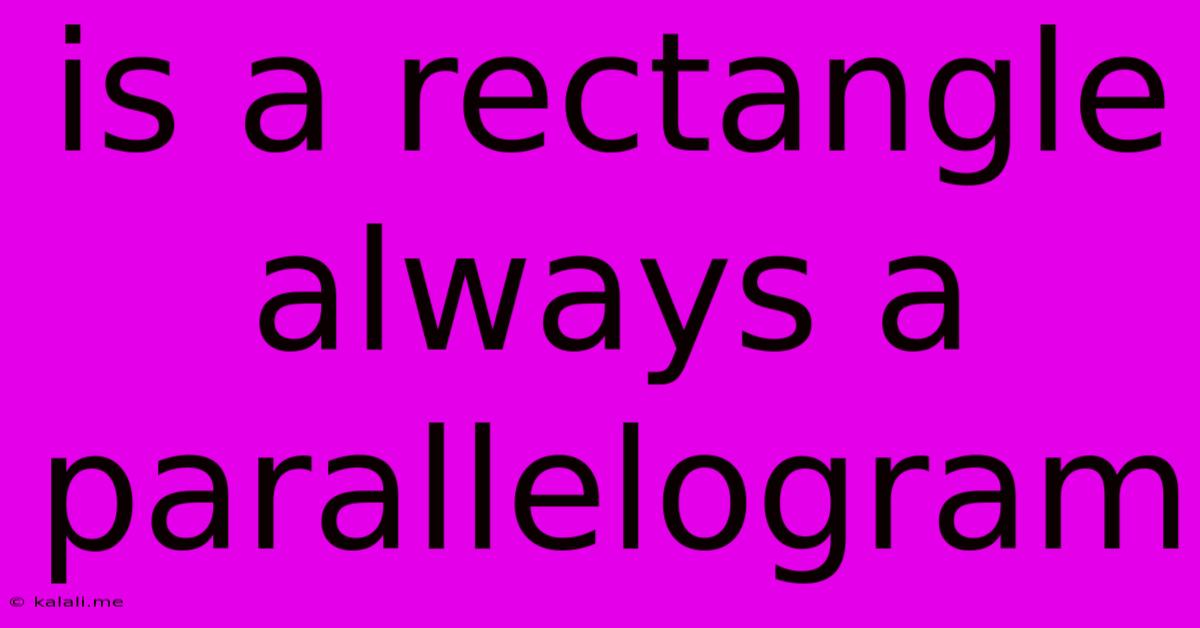Is A Rectangle Always A Parallelogram
Kalali
May 09, 2025 · 2 min read

Table of Contents
Is a Rectangle Always a Parallelogram? A Deep Dive into Quadrilateral Geometry
Is a rectangle always a parallelogram? The short answer is a resounding yes. Understanding why requires a closer look at the defining characteristics of both rectangles and parallelograms. This article will explore the geometrical properties that solidify this relationship, providing a clear and concise explanation suitable for students and enthusiasts alike.
What is a Parallelogram?
A parallelogram is a quadrilateral – a four-sided polygon – with two pairs of parallel sides. This fundamental characteristic leads to several other important properties:
- Opposite sides are equal in length: The lengths of opposite sides are congruent.
- Opposite angles are equal in measure: The angles opposite each other are congruent.
- Consecutive angles are supplementary: Adjacent angles add up to 180 degrees.
- Diagonals bisect each other: The diagonals intersect at their midpoints.
What is a Rectangle?
A rectangle is also a quadrilateral, but with a more specific definition: it's a parallelogram with four right angles (90-degree angles). This seemingly small addition significantly impacts its properties. Because a rectangle is a parallelogram, it inherits all the properties listed above. In addition, a rectangle has:
- All angles are 90 degrees: This is the defining characteristic that distinguishes it from other parallelograms.
- Diagonals are equal in length: Unlike other parallelograms, the diagonals of a rectangle are congruent.
Why a Rectangle is Always a Parallelogram
The key to understanding the relationship lies in the definitions. The definition of a parallelogram solely focuses on parallel sides. The definition of a rectangle builds upon this, adding the constraint of right angles. Since a rectangle satisfies the condition of having two pairs of parallel sides (inheriting this from the parallelogram definition), it automatically qualifies as a parallelogram. Therefore, every rectangle is a parallelogram, but not every parallelogram is a rectangle.
Think of it like this: parallelograms are a broader category, while rectangles are a more specific subcategory within that category. All rectangles are parallelograms, but there are many parallelograms that are not rectangles (e.g., rhombuses, squares).
Visualizing the Relationship
Imagine a Venn diagram. The larger circle represents all parallelograms. Inside that circle, a smaller circle represents all rectangles. The smaller circle (rectangles) is entirely contained within the larger circle (parallelograms), illustrating that all rectangles are a subset of parallelograms.
Conclusion:
The geometrical relationship between rectangles and parallelograms is definitive. A rectangle always fulfills the criteria of a parallelogram due to its inherent parallel sides. This understanding is crucial for grasping fundamental concepts in geometry and solving various related problems. Remembering the defining characteristics of each shape clarifies their relationship and allows for the logical deduction that a rectangle is, without exception, a parallelogram.
Latest Posts
Latest Posts
-
60 Inches To Feet And Inches
May 09, 2025
-
How Many Kilograms Is 5000 Grams
May 09, 2025
-
18 Is What Percent Of 75
May 09, 2025
-
What Number Is Equivalent To 1 3
May 09, 2025
-
Cuanto Es 34 Fahrenheit En Centigrados
May 09, 2025
Related Post
Thank you for visiting our website which covers about Is A Rectangle Always A Parallelogram . We hope the information provided has been useful to you. Feel free to contact us if you have any questions or need further assistance. See you next time and don't miss to bookmark.